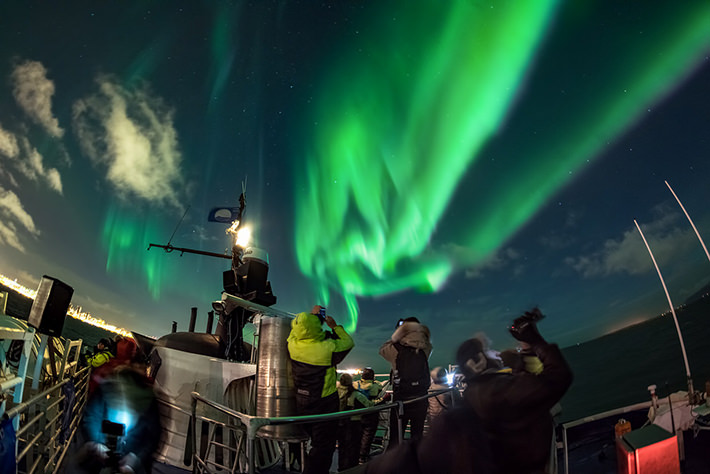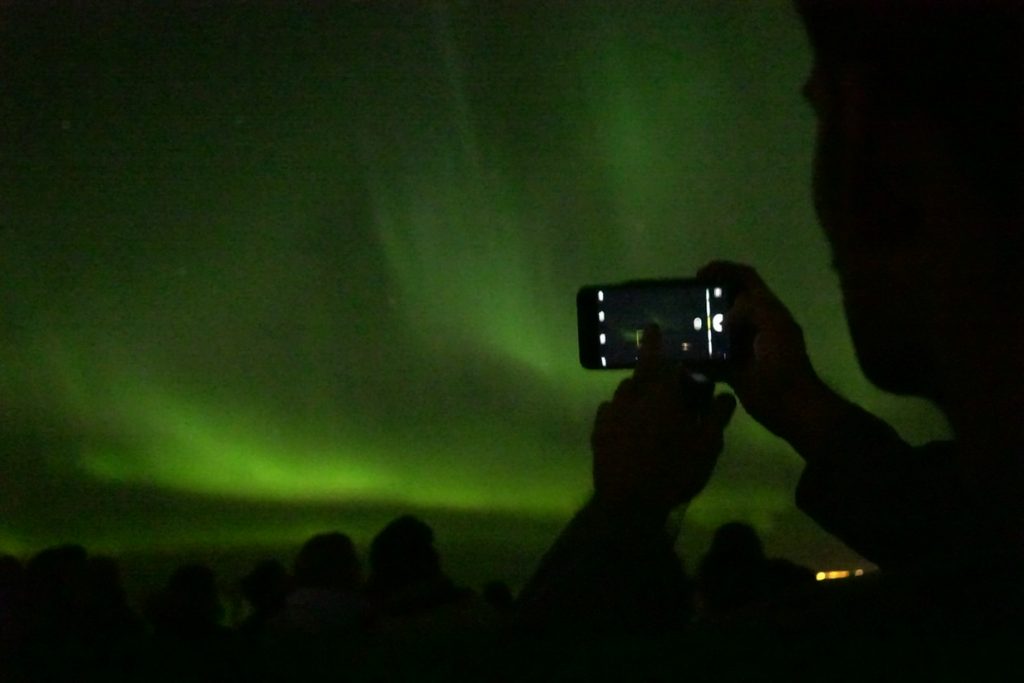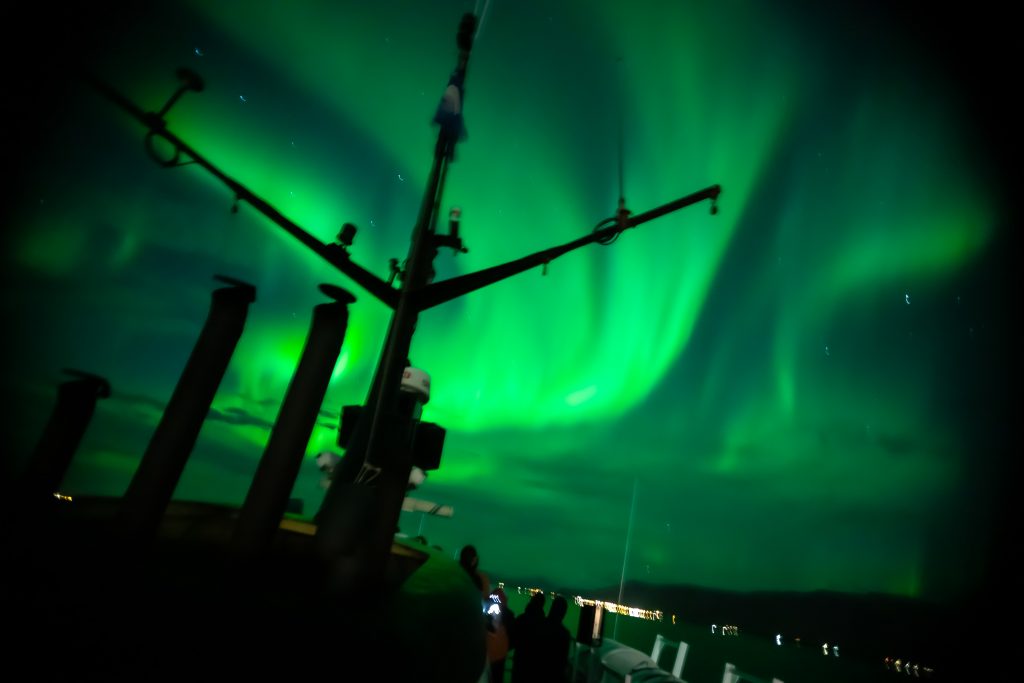Northern Lights
The Northern Lights
The Northern Lights, also known as aurora borealis, are caused by interactions between solar wind and gas molecules very high up in our atmosphere. Our sun, 150 million km (93 million mi) away, is constantly emitting solar wind which is made up of charged particles such as protons, electrons, and alpha particles. Solar wind is sent out in all directions, and some of it makes its way towards the Earth, arriving here around 40 hours later on average. The charged particles then collide with molecules of oxygen and nitrogen in the ionosphere, causing the gases to become excited and begin to glow. The light the gases emit are the Northern Lights!
In the Northern Hemisphere, the best time of year to view the auroras is from September to mid April. However, in the summertime, it’s not possible to view the auroras due to the long daylight hours.

The colors of the Northern Lights
Northern Lights can come in many different colours, which all relate to which gas molecules are being excited, and how high up they are. The most common colour of auroras is pale green, which is caused by excited oxygen molecules about 100 km (62 mi) above the Earth’s surface. Pink and red auroras are caused by oxygen as well, but much higher up – approximately 300 km (186 mi) in altitude. Purple and blue are the rarest colours, and they are caused by nitrogen molecules becoming excited at different altitudes. The brightness and colour of the Northern Lights can vary from night to night and even minute to minute. Note that perception of auroras can vary between individuals, due to factors such as: brightness of the aurora, level of adjustment to the darkness, the viewer’s age, and degrees of colour-blindness.
During a moderate to large auroral display, which can last up to three hours, the amount of energy released is roughly equivalent to a small nuclear explosion.
Typically, a display lasts for a few minutes and occurs several times per night. Auroral activity is at its most intense during the hours before midnight.
How to find the Northern Lights
In order to find the Northern Lights, it is necessary to get away from the city lights as the light pollution can and will have a big effect on your sighting chances. Dark places with little to no clouds will optimize your chances of seeing the Northern Lights and can can significantly increase one’s enjoyment of the auroras. On your Northern Lights by Boat tour you will sail away from the city lights in only 5-10 minutes. As soon as you are away from the city lights you can start looking out for the Northern Lights or the magnificent Aurora Borealis. This way you can use the whole time of your tour looking for the Northern Lights.

Northern Lights Photography
Many people who visit Iceland try to capture a photo of the Northern Lights to bring home as a souvenir. Note that not all cameras can photograph the auroras – the most capable cameras are DSLRs or mirrorless cameras, manufactured by Nikon, Canon, Sony, and other companies. Small point-and-shoot cameras, and action cameras such as GoPro, are often not able to photograph them because the sensors are small and low-end. However, some smartphones may be able to capture a photo, such as Google Pixel, Samsung Galaxy, and recent iPhones (with 3rd party apps). We will walk you through the best settings for DSLRs and mirrorless cameras, keeping in mind our maritime setting for our tours. Note that these are not the same settings you would use for tripod photography on land, because the boat is always moving, at least somewhat. The crew is happy to assist you with these settings while you are on board. Also note that it is best to use a wide-angle lens, zoomed all the way out.

Camera settings for Northern lights photography
#1
You must always have your camera set to Manual mode. There will usually be a wheel or dial at the top of your camera, which should be set to M.
#2
Your shutter speed should be between 0.5 and 1.5 seconds. If it is any slower, then your photos may appear very blurry.
#3
Your ISO sensitivity should be as high as possible. We recommend at least 6400.
#4
Your aperture, or f-stop, should be set as low as your camera allows.
#5
Then, your focal distance should be set to infinity. This can be easily done by either rotating the appropriate ring on your lens, or simply by looking through the viewfinder and focusing on something very far away. The distant lights of towns or farms around the fjord are far enough away for this purpose! It is often hard to focus on something in distance at night time so this setting can also often be done during day time and then you have to put tape over your focus sensor. This way your camera should be automatically set to infinity focus during night time. This setting of course varies between camera models.
And finally, your lens should be set to manual focus. Note that this is not the same as Manual mode – normally there is a switch on the lens itself which should be set to M or MF. Sometimes this setting can only be accessed using the camera’s on-screen menu.
Once these settings are complete, then your camera will be in the best position to take Northern Lights photos. However, we always do our best to have a photographer every evening on the Northern Lights by Boat tour, so if your camera is not capable of Northern Lights photography, or if you would just rather relax and enjoy the evening, then you will be able to download our photos from our website free of charge.
Best
Seller
Best
Seller

Northern Lights Myths and folklore
For thousands of years, people around the world have watched the Northern Lights and woven them into their folklore, beliefs, and customs. Auroras were often seen as signs from the gods, or the spirits of their ancestors. Some cultures believed them to be good luck, while others thought they were dangerous, and took shelter from them.
In Ancient Roman mythology, Aurora is the goddess of dawn, renewing herself every morning to fly across the sky, announcing the arrival of the sun.
The indigenous Sami people of Scandinavia feared the Northern Lights. They believed they could scare the lights away by clapping their hands, but whistling could cause them to come closer and appear brighter!
Here in Iceland, auroras were believed to ease the pain of childbirth – but if a pregnant woman looked at the Northern Lights, her child would be born cross-eyed! Others in Iceland believed that if the lights were dancing especially much, then it meant a big storm was coming, or that a war was occurring somewhere else in the world.
In Finland, legend spoke of an arctic fox that would run across the tundra, and its bushy tail would swipe against mountains, causing sparks to rise into the air. These sparks, or “fox fires,” were said to be the Northern Lights!
In ancient Sweden, the Northern Lights were said to be good luck, because fishermen believed the auroras were reflections from schools of herring swimming far away in the sea. They thought that if they followed the auroras, it would lead to their next big catch!
In Denmark, there was a legend of swans who would hold competitions to see who could fly the farthest north. As they flapped their wings, the ice that formed on them would reflect sunlight and glisten, resulting in the auroras.
In Norse mythology, there were female warrior spirits called the Valkyries, and it was their job to decide the fates of warriors in battle. The most honourable warriors dined and drank with the gods in Valhalla in the afterlife. It was said that the Valkyries’ shining golden armour would reflect the sun as they rode through the skies, causing the Northern Lights.
Sometimes when the Aurora is large and extends to more southern latitudes, it takes on a dark red hue. In the past, people of southern Europe linked this to blood in battle, and saw it as the harbinger of calamity. Before the onset of the French Revolution, inhabitants of Scotland and England reported hearing the sounds of battle and seeing images of great armies engaging each other in the skies. Similar dramatic sightings were recorded on January 25th, 1938 as Europe stood on the brink of another World War.
In Greenland, some Inuit consider the Aurora to be the spirits of departed children. The mood of the spirits could be sensed from the formation and movement of the Aurora. When they were happy, the lights danced about in the sky, but if they were sad, the lights were still. Sometimes they were resentful, and then the lights rushed Earthwards attempting to prevent the souls of the newly dead from ascending.
In China and Japan, the Northern Lights have also been linked to fertility, being considered a prediction of a forthcoming birth. Some believe that the children conceived under the Northern Lights will prosper and will be blessed with good luck.
To look skywards on a crisp, clear night and see these giant curtains of light weaving and swaying, gliding and flowing gracefully across the northern heavens is pure magic. The Norwegian poet Knut Hamsun, in his poem Snow, aptly described the aurora as a heavenly feast
inspired the scientific and the artistic in man. But while scientific knowledge of the 21st century may at last offer us a cold and precise explanation of this magnificent phenomenon, we should never cease to relish the fascinating tales of old, rejoice in the aurora’s entrancing beauty and mystery, and embrace the cosmic experience it offers.

Why choose Northern Lights by Boat
When you choose your Northern Lights tour there are many things that you should consider. The way of travel, the quality of the guides, flexibility, access to restrooms e.t.c.. And what if there are no Northern Lights seen on the tours what then?
Special Tours – Wildlife Adventures were the first company to start offering Northern Lights by boat tours in Iceland. The tours depart from the old harbor in Reykjavik and only take about 2-3 hours. But out of all the Northern Lights tour options in Iceland, why should you choose to go out hunting for Northern Lights by boat?
– Guidance: The tour is always guided by a quality guide and includes a whole lot of information about the Northern Lights, myths and some personal touch on the Northern Lights.
– What if we don´t see any Northern Lights: If there are no Northern Lights seen on the tour you can try again for free (return ticket valid indefinitely)
– Flexibility during the tour: You can move freely around the boat during the tour. Stay inside in the warm and cozy seating areas or go outside and look for the Northern Lights. Please note that you will be informed about all sightings so when the Northern lights are spotted, you can go out to our very large viewing decks to enjoy this magnificent natural phenomenon that is the Northern Lights or the Aurora Borealis as some call them.
– The Special Tours Iceland Application: Free informative app in five different languages (English, German, Spanish, French and Mandarin). Includes, texts images and sound files about your tour. Published for both ios and Android
– Other things to consider: Warm overalls are provided on the tour, Free Wifi, excelent sound system, restrooms on board, refreshments sold on the on-board bar,
– What if my tour gets cancelled due to weather?
Well then you can choose from a few different options. You can of course opt for a full refund. You can also choose to re-book your tour for another night (this is why we always recommend booking a Northern Lights tour for your first night). You can also choose to go on our Northern Lights by Boat with a backup plan tour which includes a guided tour around the Whales of Iceland Exhibition, a 25 min long documentary and a free drink at the bar, keeping your ticket to join the Northern Lights by Boat tour on another night. This option can also be selected for the original Northern Lights by Boat tour.
The short version of why you should choose Northern Lights by Boat.
During Northern Lights by Boat tour you have…
- Freedom to move around the boat during the tour.
- Comfortable heated cozy inside seating.
- Cafeteria, bar and a souvenir shop on-board.
- Access to restrooms at all times.
- Free Warm Overalls
- Free Wi-FiP
- Panoramic ocean view of Reykjavik City.
- Experiences Northern Lights guides and crew.
- Option to spend more time outside viewing the Northern Lights than on many other tours.
- Crew members can be asked for photography assistance if needed.
We hope you enjoy your Northern Lights tour in Iceland.
Read more about this in our blog article about things to know before your Northern Lights Adventure.

The Season for Northern Lights in Iceland
Iceland is becoming more and more known as a destination to see the amazing natural phenomenon called the Northern Lights or the Aurora Borealis. The Iceland Northern Lights season usually starts in the beginning of September and ends around the 15th of April. The season is not affected by the Northern Lights themselves, only the time of year when it gets dark enough for them to be visible. In summer there is simply too much daylight around the clock in Iceland to be able to see the Northern Lights!
The best way to be able to see the Northern Lights in Iceland is to start by visiting Iceland during the Northern Lights season, but that´s not all because you must take a few other factors into the picture. The chances of Seeing Northern Lights in Iceland rise with increased solar activity, but you also must have clear or partly clear skies for the Northern Lights to be visible. It is also recommended to escape any light pollution from the city lights or any other surrounding lights. You can read more details about the Northern Lights forecast, how to photograph the Northern Lights and what to bring on a Northern Lights tour in another Wildlife Adventure blog article here.
Read more about the Best
in our blog about the best time to see Northern Lights in Reykjavík.








